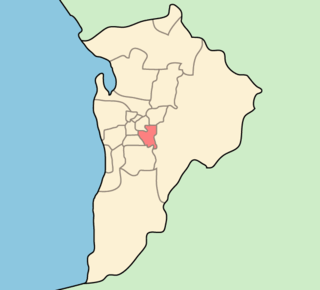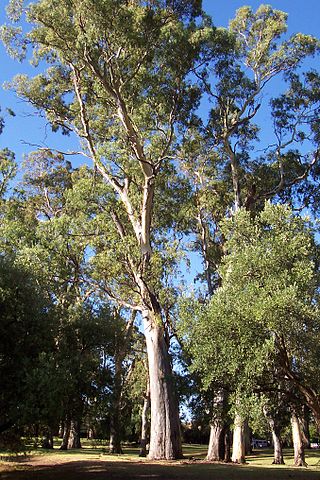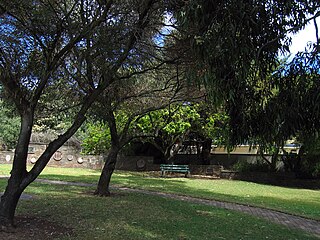Related Research Articles

Waterfall Gully is an eastern suburb of the South Australian capital city of Adelaide. It is located in the foothills of the Mount Lofty Ranges around 5 km (3.1 mi) east-south-east of the Adelaide city centre. For the most part, the suburb encompasses one long gully with First Creek at its centre and Waterfall Gully Road running adjacent to the creek. At the southern end of the gully is First Falls, the waterfall for which the suburb was named. Part of the City of Burnside, Waterfall Gully is bounded to the north by the suburb of Burnside, from the north-east to south-east by Cleland National Park, to the south by Crafers West, and to the west by Leawood Gardens and Mount Osmond.

Norwood is a suburb of Adelaide, about 4 km (2.5 mi) east of the Adelaide city centre. The suburb is in the City of Norwood Payneham & St Peters, whose predecessor was the oldest South Australian local government municipality.

The City of Burnside is a local government area in the South Australian city of Adelaide stretching from the Adelaide Parklands into the Adelaide foothills with an area of 2,753 hectares. It was founded in August 1856 as the District Council of Burnside, the name of a property of an early settler, and was classed as a city in 1943. The LGA is bounded by Adelaide, Adelaide Hills Council, Campbelltown, Mitcham, Norwood Payneham and St Peters and Unley.
Glenside is a suburb in the local government area known as the City of Burnside, Adelaide, South Australia. The suburb is 4.9 kilometres south-east of the Adelaide city centre, home to 2,422 people in a total land area of 1.40 km2.
Mount Osmond is a small suburb of 2,497 people in the South Australian capital city of Adelaide. It is part of the City of Burnside local government area and located in the foothills of the Adelaide Hills, five kilometres south east of the city centre. The suburb is high on the hill of the same name, which is the last hill on the right when approaching Adelaide down the South Eastern Freeway before the road levels out onto the Adelaide Plains. It is bounded to the north by the suburb of Beaumont, to the north-east by Burnside, to the east by Waterfall Gully, to the south by Leawood Gardens/Eagle On The Hill, to the south-west by Urrbrae, to the west by Glen Osmond and to the north-west by St Georges.
Dulwich is a suburb in the City of Burnside, Adelaide, South Australia with a census area population of 2,663 people. The suburb is adjacent to Adelaide's east parklands, and forms part of the western boundary of the City of Burnside. Dulwich is a mix of residential housing and commercial activity–corporate offices and businesses line Fullarton and Greenhill Roads. The suburb is bordered by Rose Park to the north, Toorak Gardens to the east, Glenside to the south and the Adelaide Parklands to the west.

Hazelwood Park is an upper class suburb in the City of Burnside, Adelaide, South Australia with a census area population of 1,717 people. The suburb is about 5 kilometres east of the Central business district. Hazelwood Park, a suburban park inside the suburb, is the major attraction in the suburb and is the start of the flat country of the Adelaide Plains at the bottom of the Adelaide Hills. Adjacent Howard Terrace is considered to be the end of the Plains and the start of the foothills. Hazelwood Park includes the Burnside Swimming Centre, a popular site in the summer. Much of the remainder of the suburb is residential but there is a small shopping area along Glynburn Road on the eastern edge. The area was first settled by Europeans in 1848 but has seen many community changes over the years.
Kensington Park is an eastern suburb of Adelaide in the City of Burnside in South Australia. It is bordered by Magill Road to the north, Glynburn Road to the east, Kensington Road to the south, and Gurrs and Shipsters Roads to the west.

Rose Park is a suburb with a population of 1,374 in the South Australian capital city of Adelaide. It is located 1 kilometre (0.62 mi) east of Adelaide's central business district. Rose Park is a leafy, tree-lined and wealthy inner suburb containing a number of historical and contemporary attractions. Much of the area's 19th-century housing stock has been recognised with heritage protection.

Rosslyn Park is an eastern suburb of Adelaide in the City of Burnside.

Stonyfell is an eastern suburb in the foothills of Adelaide, Australia, within the council area of the City of Burnside. It has parks with walking tracks, and two creeks running through it. St Peter's Collegiate Girls' School is the only school in Stonyfell. There is a quarry and a winery, the present-day remnants of industries dating back to the early days of the colonisation of South Australia.
Heathpool is a residential suburb of Adelaide, Australia, east of the city, in the City of Norwood Payneham St Peters.
Kensington is a suburb of Adelaide, South Australia in the City of Norwood, Payneham & St Peters council area. Unlike the rest of the city, Kensington's streets are laid out diagonally. Second Creek runs through and under part of the suburb, which contains many heritage buildings as well as Norwood Swimming Pool.
Marryatville is a small suburb about 4–5 kilometres (2.5–3.1 mi) east of Adelaide's central business district, in the local council area of City of Norwood Payneham St Peters. Comprising low- to medium-density housing, two large schools, a church and several shops, it also has two creeks running through it. The first European settler on the land was George Brunskill in 1839, with part of the land purchased and laid out as a village in 1848 by James Philcox.

The history of the City of Burnside, a local government area in the metropolitan area of Adelaide, spans three centuries. Prior to European settlement Burnside was inhabited by the Kaurna people, who lived around the creeks of the River Torrens during the winter and in the Adelaide Hills during the summer.

Parafield Gardens is a suburb of Adelaide, South Australia. The suburb is largely residential, with a pocket of industrial land in the southwest corner. There are two small shopping centres in the area, one on Salisbury Highway, and another on Sheperdson Road.

Glenelg East is a residential suburb 9 kilometres (5.6 mi) south-west of the centre of Adelaide, South Australia. It is characterised by quarter-acre blocks with heritage homes and parks intermingled with contemporary modern homes and low-rise multi-dwelling units.

The Kensington Oval is located on 344 The Parade, Kensington, South Australia. Now used primarily for cricket in South Australia, the venue was once Adelaide's premier athletics facility and known as Olympic Sports Field.
The Regal Theatre, formerly known as the Chelsea Cinema, the Princess Theatre and the Ozone Marryatville or Marryatville Ozone Theatre, is a single-screen cinema in Kensington Park, a suburb of Adelaide, South Australia. Originally built in 1925, it retains the features of a major renovation in Art Deco style in 1941, and was heritage-listed on the state register in 1983. It is the oldest continuously running purpose-built cinema in Adelaide, and the only remaining silent cinema still operating.
References
- ↑ Australian Bureau of Statistics (28 June 2022). "Kensington Gardens (Suburb and Locality)". Australian Census 2021 QuickStats. Retrieved 28 June 2022.
- ↑ O'Brien, Lewis Yerloburka; Paul, Mandy (8 December 2013). "Kaurna People". Adelaidia. Retrieved 20 September 2020.
- ↑ "Our early beginnings". City of Burnside. Retrieved 20 September 2020.
- 1 2 3 Manning, Geoffrey H. (2002). "Place Names of South Australia – K". The Manning Index of South Australian History. Retrieved 20 September 2020– via State Library of South Australia.
- 1 2 "Proposed Co-name – Kensington Wama / Kensington Gardens Reserve". engage.burnside. 11 June 2022. Archived from the original on 11 June 2022. Retrieved 11 June 2022.
- 1 2 "The Eastern Lines". Tramway Museum, St Kilda. 17 March 1956. Retrieved 20 September 2020.
- 1 2 3 "Kensington—Old and New". The Observer (Adelaide) . Vol. LXXX, no. 5, 961. South Australia. 28 April 1923. p. 14 – via National Library of Australia. [cont. next page] "Kensington—Old and New [cont.]". The Observer (Adelaide) . Vol. LXXX, no. 5, 961. South Australia. 28 April 1923. p. 15. Retrieved 20 September 2020– via National Library of Australia.
- ↑ "Burnside Heritage Survey (South Australia): Part One: General Report" (PDF). Heritage Investigations. Prepared for the Corporation of the City of Burnside and the State Heritage Branch of the Department of Environment and Planning by John Dallwitz and Alexandra Marsden of Heritage Investigations, Adelaide 1986. (amended July 1987). City of Burnside and the Australian Heritage Commission. 1987.
{{cite web}}: CS1 maint: others (link) - ↑ "The Names of Adelaide, South Australia". Pocket Oz Guide to Australia. Retrieved 20 September 2020.
- ↑ City of Burnside (2006). "Celebrating Our city – 150 Years" (PDF).
- ↑ "Kensington Gardens Reserve Project – Official Opening". engage.burnside. 8 March 2022. Archived from the original on 8 March 2022. Retrieved 11 June 2022.
34°55′34″S138°39′47″E / 34.926°S 138.663°E